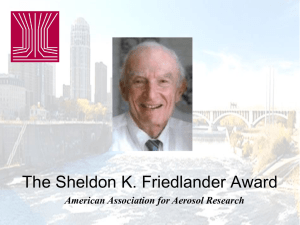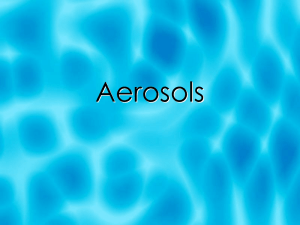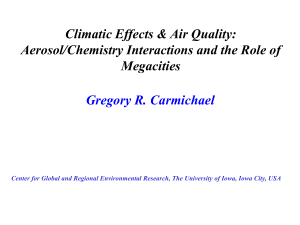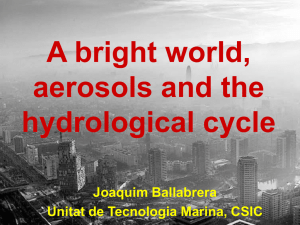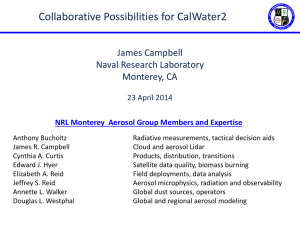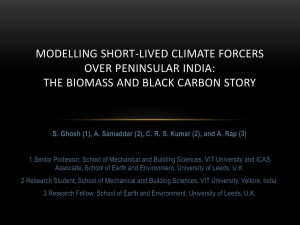BimodalHistoryHusar1
advertisement
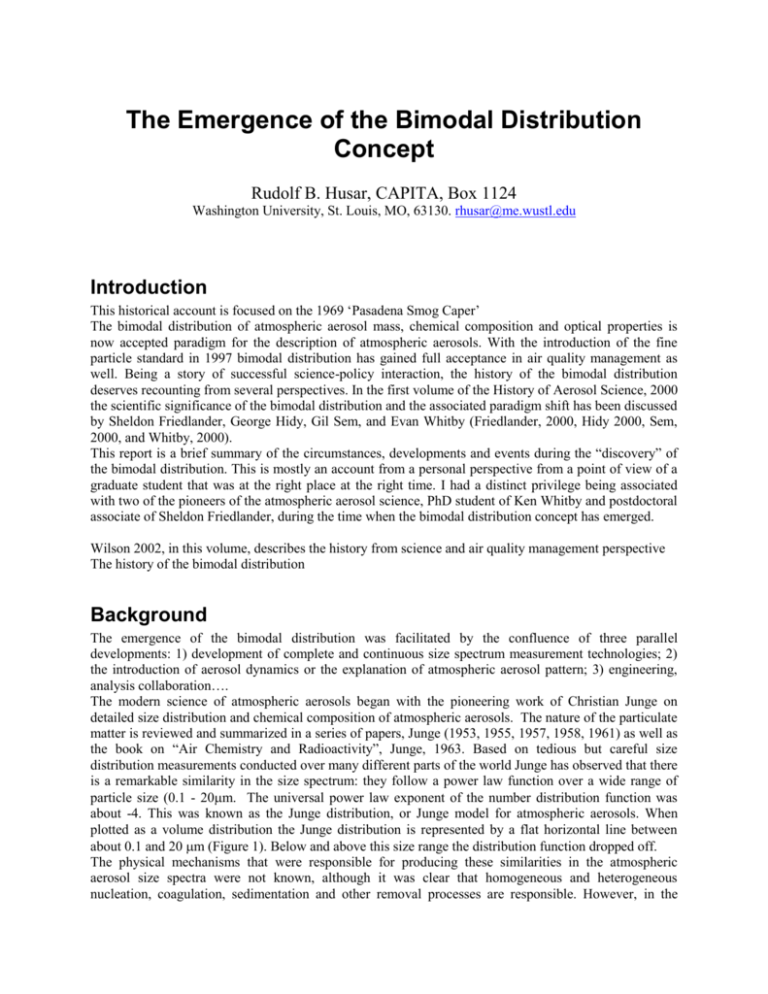
The Emergence of the Bimodal Distribution Concept Rudolf B. Husar, CAPITA, Box 1124 Washington University, St. Louis, MO, 63130. rhusar@me.wustl.edu Introduction This historical account is focused on the 1969 ‘Pasadena Smog Caper’ The bimodal distribution of atmospheric aerosol mass, chemical composition and optical properties is now accepted paradigm for the description of atmospheric aerosols. With the introduction of the fine particle standard in 1997 bimodal distribution has gained full acceptance in air quality management as well. Being a story of successful science-policy interaction, the history of the bimodal distribution deserves recounting from several perspectives. In the first volume of the History of Aerosol Science, 2000 the scientific significance of the bimodal distribution and the associated paradigm shift has been discussed by Sheldon Friedlander, George Hidy, Gil Sem, and Evan Whitby (Friedlander, 2000, Hidy 2000, Sem, 2000, and Whitby, 2000). This report is a brief summary of the circumstances, developments and events during the “discovery” of the bimodal distribution. This is mostly an account from a personal perspective from a point of view of a graduate student that was at the right place at the right time. I had a distinct privilege being associated with two of the pioneers of the atmospheric aerosol science, PhD student of Ken Whitby and postdoctoral associate of Sheldon Friedlander, during the time when the bimodal distribution concept has emerged. Wilson 2002, in this volume, describes the history from science and air quality management perspective The history of the bimodal distribution Background The emergence of the bimodal distribution was facilitated by the confluence of three parallel developments: 1) development of complete and continuous size spectrum measurement technologies; 2) the introduction of aerosol dynamics or the explanation of atmospheric aerosol pattern; 3) engineering, analysis collaboration…. The modern science of atmospheric aerosols began with the pioneering work of Christian Junge on detailed size distribution and chemical composition of atmospheric aerosols. The nature of the particulate matter is reviewed and summarized in a series of papers, Junge (1953, 1955, 1957, 1958, 1961) as well as the book on “Air Chemistry and Radioactivity”, Junge, 1963. Based on tedious but careful size distribution measurements conducted over many different parts of the world Junge has observed that there is a remarkable similarity in the size spectrum: they follow a power law function over a wide range of particle size (0.1 - 20m. The universal power law exponent of the number distribution function was about -4. This was known as the Junge distribution, or Junge model for atmospheric aerosols. When plotted as a volume distribution the Junge distribution is represented by a flat horizontal line between about 0.1 and 20 m (Figure 1). Below and above this size range the distribution function dropped off. The physical mechanisms that were responsible for producing these similarities in the atmospheric aerosol size spectra were not known, although it was clear that homogeneous and heterogeneous nucleation, coagulation, sedimentation and other removal processes are responsible. However, in the 1960s it was not clear which particular combination or mechanisms are responsible for maintaining the similarity of the size spectra. In a series of articles based on dimensional analysis and similarity theory, S. K. Friedlander (1960a, 1960b, 1961) has shown that IF coagulation and sedimentation were the dominant physical mechanisms, then a significant part the aerosol spectrum would follow the power law shape. In essence, the implication of this theory was that the observed quasi-stationary size distribution could be the result of balancing aerosol production (nucleation) and removal (sedimentation). It should be recalled that complete size distribution data covering the entire 0.01-10 m size range were virtually non-existent. That has changed when Clark and Whitby (1967)reported an extensive set of complete size distribution measurements for Minneapolis using the newly developed Minnesota Aerosol Analyzing System (see next section). The new aerosol size distribution data were welcomed by the atmospheric aerosol research community and sparked a vigorous debate regarding the Junge distribution and its possible explanations. Clark and Whitby (1967) themselves spoke in favor Friedlander’s ideas but Junge (1969) swiftly responded that the ‘self-preserving’ distritibution of a coagulating aerosol can be ruled out as an explanation of the atmospheric power-law data with negative slope4: the slope of that a self-preserving coagulation size distribution is much steeper. Also, Junge argued, that since thermal coagulation is a weak mechanism for changing the size range >0.1 m, there must be other stronger mechanisms that govern the atmospheric aerosol dynamics. He named homogeneous and heterogeneous gas-particle conversion, and cloud scavenging as candidate processes. However, he has declined to speculate the relative roles and magnitudes of these processes. Fig 1 In a significant statement, Junge also re-emphasized his earlier findings, that the slope of the power – law distributions can be rather different, depending on the aerosol type as reproduced in Figure 1 (Junge 1969). For example, the volume spectra of upper tropospheric aerosols has a peak at around 0.1 0.1 m radius, while marine aerosol has a broad peak at 1-20 m. Only the aerosols observed in the continental boundary layer show the flat Junge distribution with 4 over the 0.1-100 m radius range. Finally, he ventures to provide and alternative explanation for the broad Junge spectrum: Continental aerosol arise from many different aerosol sources, each having a different size between 0.1-100 m. When these aerosols are mixed in the atmosphere, they form a size spectrum that can be represented by a broad lognormal distribution that resembles the typical flat Junge spectrum. This was the state of understanding in 1969 as the ……… Aerosol Measurement Technology Until the late 1960s aerosol size distribution was obtained using tedious impactor and filter measurements, electron microscopy and other time consuming techniques that precluded continuous monitoring. The total number of measurements that covered the 0.1-10 m were very limited, probably in the range of 50-100 spectra. Starting in the mid 1960s Ken Whitby and Ben Liu at the University of Minnesota Particle Technology Laboratory have developed or adapted a suite of instruments for near continuous in situ monitoring of atmospheric aerosol size spectra. The heart of the instrument package was the electrical mobility analyzer covering the size range 0.008 – 0.5 m. Atmospheric particles were passed through a diffusion charger a subsequently separated by the electric mobility. The current resulting from deposition of particles in a given mobility range was used as a measure of aerosol concentration in a given mobility range. The instrument relied on the fact that the electrical mobility of charged particles was monotonically decreasing with increasing particle size. This allowed particle size segregation in the size range 0.008 0.3 m. A history of the electrical mobility analyzer is given in Sem (2000) In the mid 1960s optical particle counters were made available commercially. Ken Whitby and Ben Liu have also made significant improvements in the size resolution of optical particle counters. In the commercial counters a wide jet of atmospheric aerosols was passed through the illuminated volume and the scattered light pulse from the individual particles was classified by a multi-channel pulse height analyzer. Whitby and Liu have introduced the “sheath” air inlet such that the aerosol particles were passed through a uniformly illuminated center of the light beam. The result was a significant improvement in the size resolution. Fig 2 The Minnesota Aerosol Analyzing System, MAAS, as prepared for the 1969 Pasadena experiment is shown in Figure 2. The white cabinet houses one of the first TSI commercial mobility analyzers (Whitby Aerosol Analyzer). The Royco optical counter, equipped with the sheath air inlet along with the multichannel pulse height analyzer is house in a separate cabinet. The suite of MAAS instruments was completed by the General Electric condensation nuclei counter that was used to continuously monitor the total nuclei count > 0.01 m. The analog and digital data from these MAAS and other meteorological instruments were gathered by the data acquisition system with the data acquisition frequency of 20 minutes. As a result a total of 350 complete size distributions were recorded during the three-week study. The digital data recorder was a teletype machine equipped with the punch tape unit that recorded the digital data as holes in a continuous paper tape. Ken Whitby was justifiably very proud of the modern data acquisition system. This data acquisition and recording system allowed swift computer processing of the size distributions and other monitoring data. In fact, the prompt availability of the size distribution data to the other collaborating research groups allowed synergistic collaboration between the Minnesota and other groups. For example, Dave Ensor and Bob Charlson could immediately work on calculating aerosol light scattering from the size distribution data and compare those to their four wavelength nephelometer data. In 1969 the editing of data was rather similar to the currently used cut-and-paste graphic user interfaces. The difference was that in 1969 cut meant cutting the paper punch tape with scissors, replacing the bad data with a new punched tape section and pasting the new tapes with the appropriately perforated sticky tape. Fig 3 A significant factor during the 1969 Pasadena study was the stimulating intellectual environment. Not only the leaders of the project Ken Whitby, Sheldon Friedlander and Peter Mueller were providing the stimulating environment, but the project has attracted several “junior” scientists e.g. Bob Charlson, George Hidy who eagerly contributed their instruments and rich set of ideas while the monitoring was in progress. In Figure 4, for example Bob Charlson is conducting an animated discussion regarding an interesting shift in the four wavelength nephelometer signal. Fig 4 For us graduate students this was an intense learning experience on how “science” is conducted. Throughout the experimental period our host Sheldon Friedlander has brought in many visiting dignitaries, including Ari Hagen-Smit, the “discoverer” of the Los Angeles smog and chairman of the California Air Resources Board. This high visibility provided the impetus to analyze and display the collected data and to discuss the features of the size distribution with the participants and visitors. Fig 5 Since the MAAS data acquisition and recording was completely automatic it freed much of our time for special experiments. Discussions with the participants RESULTS In the 1950s, Christian Junge has proposed that atmospheric aerosols obey the monotonic power-law of the size spectra, n (D) = D- , where the exponent was generally found to be about = 4 over particle diameter range 0.05 < D < 20 m. An alternative ‘model’ is the bimodal distribution, introduced around 1970, by K.T. Whitby according to which atmospheric aerosols can be divided into two distinct aerosol classes: fine and coarse particles, each having a distinct mode in the aerosol volume distribution function. The emergence of the bimodal concept was the result of simultaneous developments in highresolution in-situ size distribution measurement techniques and theoretical studies in aerosol size distribution dynamics. In the 1960s K.T. Whitby and co-workers have developed the Electrical Aerosol Analyzer (EAA) for in situ size spectrum measurements in the range 0.01 < D < 0.3 m. When combined with modified commercial optical particle counters (OPC) and data acquisition electronics, the ‘Whitby system’ was capable of near-continuous size spectrum measurements over the range 0.01<D<10 m. The full system was first field-tested in 1968 in Colorado and operated routinely during the 1969 ‘Pasadena Smog Caper’. The Pasadena smog aerosol data have shown a remarkably persistent peak in the volume distribution around D = 0.2–0.5 m followed by a minimum at about 1-2 m. The second (coarse particle) peak was not fully covered due to the 10 m upper size of the optical counter. Both, the persistent volume peak and the volume minimum were unexpected and evoked many doubts, particularly in the accuracy of the instrumentation: Is it due to the poor size resolution of the EAA? Is it an artifact of OPC? Is it universal or unique to the Los Angeles smog aerosol under specific conditions? The concept of the bimodal distribution was formally presented by Whitby and co-workers in 1972. The emergence of the bimodal distribution was also a boost to the theory of atmospheric aerosols. It allowed a more rigorous treatment of atmospheric aerosols as a dynamic system governed by well-defined physical and chemical processes. Following the ideas of S.K. Friedlander and co-workers, the early theoretical work was focused on the understanding of the dynamics of the sub-micron (accumulation) mode. Monte Carlo and other simulations by R.B. Husar have demonstrated that condensational growth of gaseous precursors on existing nuclei is mainly responsible for the aerosol growth in the 0.1-1.0 m accumulation mode. The simulated size distributions have confirmed the observations that the volume growth (accumulation) occurs without much change in characteristic particle size. Coagulation was found to be the key mechanism for the fast decay of sub-0.1 particles at night and did not appear to influence the dynamics of the ‘accumulation-mode’ particles in the LA basin. Subsequent confirmation the bimodality as a robust concept came from (1) comparing size spectra from numerous locations and times (2) chemical composition data showing different aerosol species in the fine and coarse modes (3) theoretical calculations on the size spectrum dynamics. Research over the past 30 years has demonstrated that fine and coarse particles have different sources and are also responsible for different effects on human health and welfare. In 1998 EPA has adopted a separate air quality standard for fine particles (PM2.5). References Clark and Whitby (1967) Wilson 2002 Junge 1953, Junge, 1955, Junge 1957, Junge, 1958, Junge, 1961 Junge 1967 Junge, 1963Air Chemistry and Radioactivity, S. K. Friedlander (1960a, S. K. Friedlander (1960b) S. K. Friedlander (1961) (Friedlander, 2000, Hidy 2000, Sem, 2000, and Whitby, 2000)
